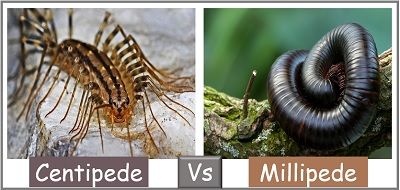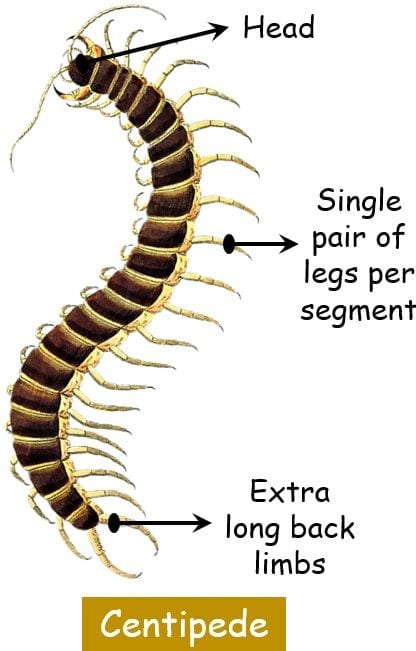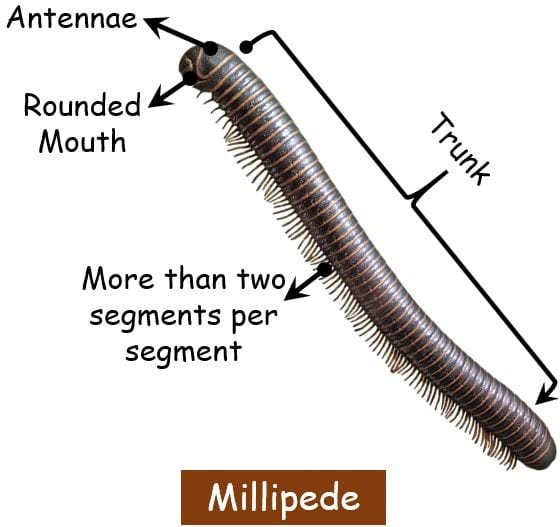Both centipede and millipede belong to the phyla Arthropoda and sub-phyla myriapods. The myriapod is a Greek terminology that means ‘Numerous feet’. And since the centipede is a hundred-legged worm while the millipede is a thousand-legged worm, therefore they fall under this category.
The centipedes are flat flexible worms with approx. 100 legs. Their body has 15-100 segments. Each segment bears a single pair of legs. While the millipede is a sub-cylindrical worm having around 1000 legs. Their body has around 11-150 segments. Each segment possesses two or more than two pairs of legs.
The centipedes belong to class Chilopoda, while the millipede comes under class Diplopoda. The centipedes are predators, and they eat small insects. Whereas the millipedes are detrivores that feed on the decaying debris.
Even though they look alike, there are plenty of differences between them. Thus, in this section, we will learn about the differences between the centipede and millipede.
Content: Centipede Vs Millipede
Comparison Chart
| Basis of Comparison | Centipede | Millipede |
|---|---|---|
| Common Name | Hundred-Legged worm | Thousand-legged worm |
| Class | Chilopoda | Diplopoda |
| Shapes | Have dorsoventrally flatted body (Only exception: Scutigeromorpha | Have a variety of body forms, but dominantly, their body is subcylindrical |
| Length | 4-12 inches | 1-8 inches |
| Colouration | Dark brown or yellowish-grey in colour | Bright black or brown colour |
| Habitat | Found almost in all types of terrestrial habitat, including soil, arid desserts, rainforests etc. | Prefer moist and humid places like gardens, flower beds, leaf litter etc. |
| Reproductive Tract | The tract opens at the body’s caudal end, i.e., Opisthogoneate | Here, the tract is progoneate as it opens at the body’s posterior end (at 3rd segment mainly) |
| Number of eggs laid | 10-50 eggs at a time | 10-300 eggs at a time |
| Nutrition | They are predatory or carnivores; eats small insects | They are scavengers or detrivores; survives over dead and decayed material |
| Body Segment | 15-100 segments | 11-150 segments |
| Truck Segment | Mono-segmentation | Diplo-segmentation |
| Poisonous | Are poisonous | Non-Poisonous |
| Maxillipeds | Present; Prehensors or poisonous claws to attack | Absent; Prehensors absent |
| First Maxillae | Present | Absent |
| Gnathochilarium | Absent | Present |
| Mouth | Triagnathic with mandibles, 1st maxillae and 2nd maxillae | Dignathic with mandible and gnathochilarium |
| Legs per Segments | Single pair of legs per segment | Two or sometimes four pairs per segment |
| Leg Position | Legs extend laterally throughout the body | Legs extent mid-ventrally along the body |
| Visibility of Legs | Are spread outwards and visible on both sides of body | Are aligned in a line and are partially visible |
| Spiracles | These are situated laterally; are valvular, and can be closed when needed | Here, the spiracles are present ventrally; are never valvular and thus can’t be closed |
| Development | May be direct or indirect | Always direct |
| Movement | Fast runners | Slow walkers |
| Flexibility | Flexible | Non-Flexible |
| Bite | Can bite | Can’t bite |
| Antennae | Long | Short |
| Defensive Mechanism | • Use their ability to move fast to rescue themselves and flee their predators. • Inject venom for paralyzing the prey • Use their back legs to squeeze their prey | • They curl the body to make a tightened spiral in order to protect the soft underside. • The predators get away by the foul smell secreted by the them |
What is a Centipede?
The term centipede has its origin from two Latin words, ‘Centi-hundred’ and ‘pedis- foot’. Thus, often refer centipede as the ‘Hundred-legged worm’. It has its scientific name as scolopendra. And it is a member of class Chilopoda (Comes from the Greek word ‘Chelios meaning lip).
Their legs are always present as an odd number of pairs. This implies that no species of centipede possesses exact hundred legs in reality.
Classification of Centipede
Kingdom: Animalia
Phylum: Arthropoda
Subphylum: Myriapoda
Class: Chilopoda
Shape, Size and Colour
The centipedes are flat-bodied worms with hundreds of legs. The approximate length is around 4-12 inches. They are generally dark brown or yellowing grey in colour.
Habitat
No any landform on the earth is devoid of centipedes. This is because of their ability to survive in a vast range of climatic conditions. This includes arid deserts, wet rainforests, even wooden logs, litter around your house etc.
Nutrition
The centipedes are predatory carnivores with venomous bites. They survive over smaller insects. This venom helps them in catching small insects like ants cockroaches.
The first pair of limbs, called maxillipeds, are elongated forward from the body to cover the mouth. These limbs are venomous and are a sharp claw-like structure. The maxillipeds help to paralyze the prey and make the killing faster.
Characteristic of Centipede
- Each segment bears a single pair of legs.
- Respiration occurs via the trachea.
- Malpighian tubules are there for excreting waste.
- Their legs are spread outwards, due to which they are visible.
- They can run very fast by using their many legs.
- Each pair of the leg is shorter than that of its adjacent pair.
- They can possess 15-100 segments on their body
- Two pairs of maxillae and single pairs of antennae and mandibles are found in their body.
- Most of the centipede species are devoid of eyes. Some have a cluster of ocelli to form real compound eyes. But these are pseudo eyes as they have true vision. They can only differ between dark and light.
- Just like antennae, the first pair of limbs serve the role of sense organs.
- Tomosvary organs are a special type of sense organs that are only found only in some species.
- The sharp and pointed pincers called ‘Forcipules” are present in them. This is a unique characteristic that is absent in other arthropods.
Reproduction in Centipede
The centipedes are ‘Opisthogoneate‘ as their genital opening is at the caudal end of the body. They have a single genital opening, but they do not copulate.
Instead of mating, the male centipede releases and collects the spermatophores (sperms) in bundles. And the female centipede has to absorb these sperm on finding them. The males do a courtship dance to lure the female for absorbing the sperm.
After the fertilization, the female lays around 10-50 eggs at a single time. The egg discharge process occurs mainly in temperate places in springs or summers.
The time required from conception to hatching varies with species ranging from one to several months. Mother centipede lives with the eggs to secure them from danger and fungus. Later as the eggs hatch, it leaves.
Defence Mechanism of Centipede
Centipedes use their fast-moving skills to evade their predators. They bear poison glands that discharge venom in danger.
They tend to bite that cause allergic responses like itching, swelling, redness etc.
What is a Millipede?
The millipedes also fall under the phylum Arthropoda and class Diplopoda. Its scientific name is Julus. The term millipede comes from the Latin language that stands for ‘thousand feet’. Whereas, Diplopoda comes from two Greek words ‘Diplo-two’ and ‘pedis-foot’.
These are prevalent abundantly with around 80,000 different varieties. In reality, there are no species with exact thousand legs, as the name suggests. But yes, there are several hundreds of legs found over their body. The highest number of legs recorded is 750.
Millipedes are often jumbled with centipedes. But they both are widely distinct from one another.
Classification of Millipedes
Kingdom: Animalia
Phylum: Arthropoda
Subphylum: Myriapoda
Class: Diplopoda
Habitat
Being terrestrial arthropods, the millipedes prefer the wet and humid areas as a habitat. They are predominantly found in the soil of gardens and flower beds, decomposing plant waste, wet wooden logs etc.
Nutrition
The millipedes are scavengers. They feed over the dead and deteriorating matter. Thus, also referred to as detrivores. For this reason, they serve the role of ecological agents for the decomposition and nutrient cycle of soil. Millipede readily consumes the roots and leaves of small saplings.
Shape, Size and Colour
Millipedes are generally sub-cylindrical in shape with rigid and non-flexible bodies.
Their length ranges from 1-8 inches. And their colour is brighter black or brown.
Characteristics of Millipedes
- There are 15-100 segments in their body. Each segment possesses two to four legs per segment.
- Their legs are attached along the mid-ventral region of their body. These legs are present in a straight sequential manner. Due to this, their legs are not easily visible.
- Although they have many legs, they are slow movers. This is because their legs are tiny, which only aids the movement in a wave-like pattern.
- The millipedes don’t bite and are non-venomous creatures.
- They bear short antennae over their head region.
- The maxillipeds and Prehensors are completely absent in them.
- The mouth of a millipede is Dignathic and bear mandibles and gnathochilarium.
- Their truck region shows Diplo-segmentation.
- They are often seen migrating in larges masses.
- The spiracles are never valvular and are present ventrally.
Reproduction in Millipedes
Millipedes only bear a single genital opening. These are ‘Progoneate’ with the reproductive opening at the anterior end of the body. More specifically, around the 3rd segment. They copulate via gonopods that are copulatory organs located at caudal segments.
Here, both the male and female mate together. The gonopods pass the male gametes inside the female body. The female lays about 10-300 eggs at a time.
Defence Mechanism of Millipedes
Although the millipedes are not poisonous, they bear some toxic chemicals or corrosive fluids. The millipede secretes these fluids as their defence mechanism.
The toxins can cause harm to humans if touched. It can cause itching, burning and some allergic responses. In case of a threat, they curl their body into a spiral. And discharge a foul smell that drives the predators off.
Key Differences Between Centipede and Millipede
- The centipedes have a flat body, while the millipede has a subcylindrical body.
- The length of a centipede is around 4-12 inches, while that of a millipede is about 1-8 inches.
- The colour of centipedes are darker shapes of grey, yellow, black or brown. In comparison, millipede’s colours are lighter shades of red, black, and brown.
- The body of the centipede is flexible and dorsoventrally flattened. While those millipedes are rigid and non-flexible.
- The centipedes bear single pair of legs per segment. But the millipedes have two or four leg pairs in each segment.
- The antennae of centipedes are long, but that of millipedes are shorter.
- Centipedes are fast runners, while millipedes are slow walkers.
- The centipedes are hundred-legged worms, while millipedes are thousand-legged worms.
- The arrangement of centipede legs is sideways, due to which they are extended outwards. But the millipedes bear short legs present in the straight line at the bottom body.
- The centipedes are carnivores, but millipedes are detrivores.
Conclusion
We often encounter several creepy crawlies in our daily lives and are confused by their similarities. The same problem is with centipede and millipede. They both are significantly distinct but are often jumbled together.
This section provides some of the most basic and fundamental traits that distinguish them. Along with that, we also provided a brief description of their shapes, structure, habitat, structural characteristics etc.




Leave a Reply